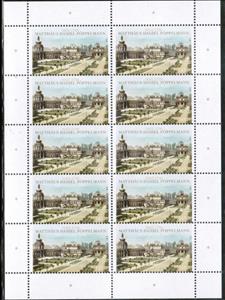Mini Sheet: 350th Birth Anniversary of Matthäus Daniel Pöppelmann (Germany, Federal Republic 2012)
350th Birth Anniversary of Matthäus Daniel Pöppelmann (Germany, Federal Republic 2012)
02 January (Germany, Federal Republic ) within release 350th Birth Anniversary of Matthäus Daniel Pöppelmann goes into circulation Mini Sheet 350th Birth Anniversary of Matthäus Daniel Pöppelmann face value 10*145 Euro cent
| Mini Sheet 350th Birth Anniversary of Matthäus Daniel Pöppelmann in catalogues | |
|---|---|
| Michel: | Mi: DE 2905KB |
Mini Sheet is square format.
Mini Sheet 350th Birth Anniversary of Matthäus Daniel Pöppelmann it reflects the thematic directions:
An anniversary is the date on which an event took place or an institution was founded in a previous year, and may also refer to the commemoration or celebration of that event. For example, the first event is the initial occurrence or, if planned, the inaugural of the event. One year later would be the first anniversary of that event. The word was first used for Catholic feasts to commemorate saints. Most countries celebrate national anniversaries, typically called national days. These could be the date of independence of the nation or the adoption of a new constitution or form of government. The important dates in a sitting monarch's reign may also be commemorated, an event often referred to as a "Jubilee".
An architect is a person who plans, designs, and oversees the construction of buildings. To practice architecture means to provide services in connection with the design of buildings and the space within the site surrounding the buildings that have human occupancy or use as their principal purpose. Etymologically, the term architect derives from the Latin architectus, which derives from the Greek (arkhi-, chief + tekton, builder), i.e., chief builder
Architecture (Latin architectura, from the Greek ἀρχιτέκτων arkhitekton "architect", from ἀρχι- "chief" and τέκτων "builder") is both the process and the product of planning, designing, and constructing buildings and other physical structures. Architectural works, in the material form of buildings, are often perceived as cultural symbols and as works of art. Historical civilizations are often identified with their surviving architectural achievements.
A building or edifice is a structure with a roof and walls standing more or less permanently in one place, such as a house or factory. Buildings come in a variety of sizes, shapes and functions, and have been adapted throughout history for a wide number of factors, from building materials available, to weather conditions, to land prices, ground conditions, specific uses and aesthetic reasons. Buildings serve several needs of society – primarily as shelter from weather, security, living space, privacy, to store belongings, and to comfortably live and work. A building as a shelter represents a physical division of the human habitat (a place of comfort and safety) and the outside (a place that at times may be harsh and harmful).




